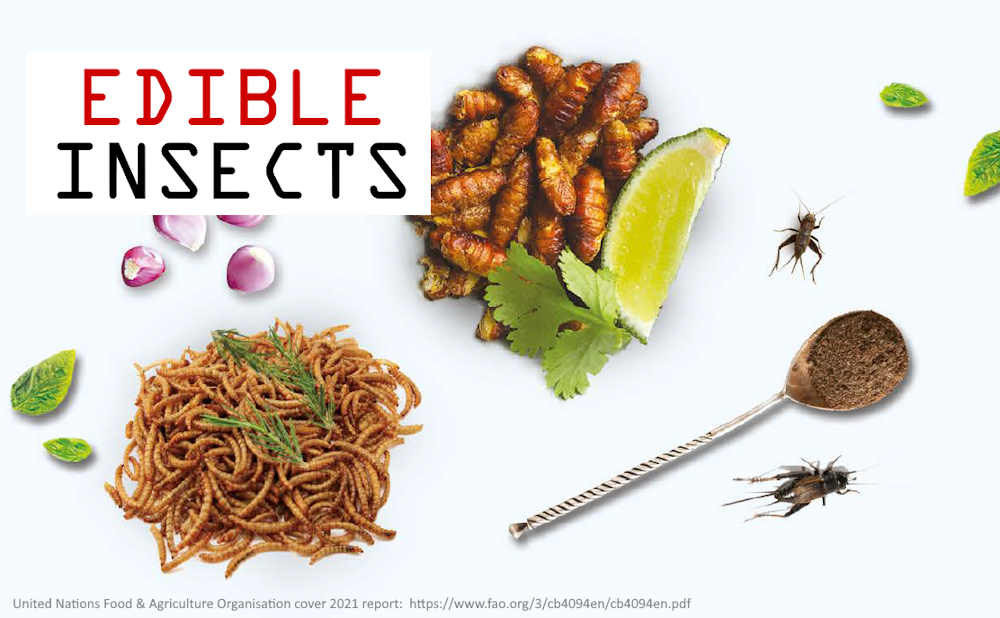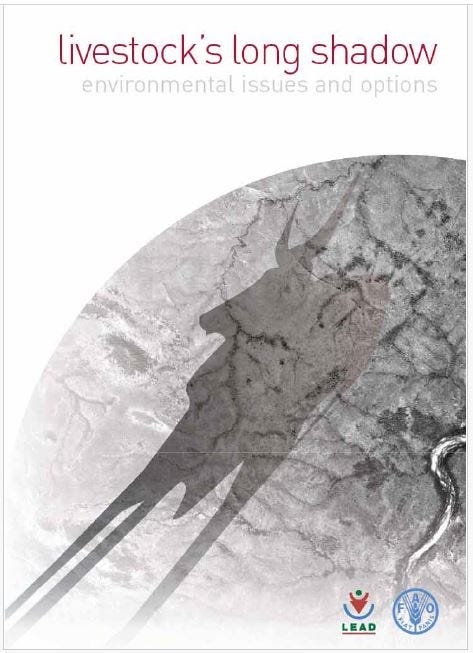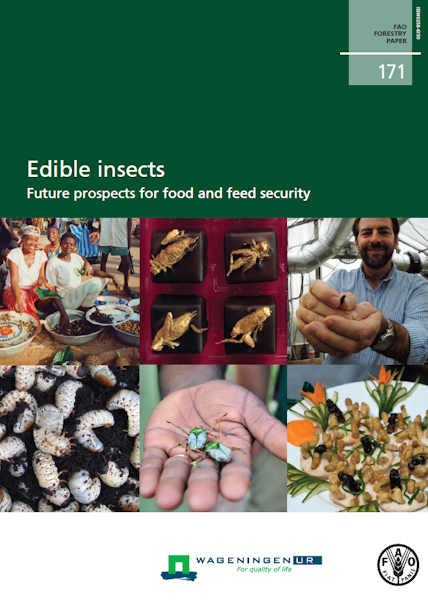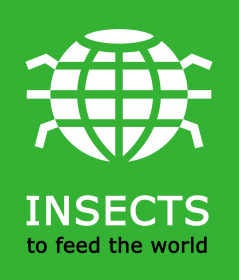UN Push"Edible Insects" for Food Security. It Slowly Morphed into Food for Everyone in the West...Because of Climate Change!
ToE timeline to help unravel how the "You Will Eat Bugs" narrative evolved
On last weeks episode of The Highwire (Ep 355 Jan 18, 2024) Jeffery Jaxen presented highlights from the World Economic Forum’s (WEF) Davos 2024 event, and in that he mentioned a 2013 report on “Edible Insects”. This prompted me to put together a timeline page at Totality of Evidence (ToE) to help my understand how this narrative evolved.
I was aware of the “Eat Bugs” push by the WEF but hadn’t looked at the history behind it. So this week I assembled a bunch of my bookmarks, together with following leads from within articles, and came up with a timeline that help to reveal the history of the narrative crafting leading to the global “movement”, and push, to eat more bugs.
Edible Insects @ ToE
The new timeline, resource page at ToE can be found at the link below. Visit and run through the links yourself to get a feel for the evolution of the current push towards substituting beef eating for crickets.
https://totalityofevidence.com/edible-insects/

Eating Bugs is not new - for some
Eating insects is not a new thing for some cultures and has not been a secret, it’s been openly brewing in the background for more than the past decade and is being driven by the United Nations. But in 2022 the World Economic Forum (the UN’s transformation partner) began telling the West YOU WILL EAT BUGS in place of meat, as they’re not only good for the planet its “good for us too”! . This push can no longer be ignored.
How has the narrative evolved?
As best as I can determine the body driving the push for EVERYONE to eat insects is the United Nations Food & Agriculture Organisation (FAO). They have the mandate “to raise levels of nutrition, improve agricultural productivity, better the lives of rural populations and contribute to the growth of the world economy in support of its 191 member countries”.1
The FAO put out a report in 2006, in collaboration with The Livestock, Environment & Development (LEAD) Initiative, and World Bank et al, titled Livestock’s Long Shadow which looked at the role of Livestock played in land use, climate change, air and water pollution and biodiversity impact.

The report has been quoted by may since to justify livestock’s threat to the planet, especially with the expected population increase by 2050.
The contribution by livestock and especially cattle to environmental problems is on a massive scale and should be addressed with urgency according to FAO’s report Livestock’s Long Shadow. Global demand for livestock products will more than double during the next 50 years (from 229 million tonnes in 1999/2001 to 465 million tonnes by 2050), and livestock production accounts already for 70% of all agricultural land. The livestock sector is an important contributor to greenhouse gas emissions such as CO2, CH4 and N2O.
2006 was the year of Al Gore’s Inconvenient Truth, when the “threat” was still communicated in the media as “Global Warming”, it seemed to be around 2008 when the narrative was more consistently “Climate Change”. In this document the FAO defines one as weather impact and the other as environmental impact.

So the FAO established that livestock was a threat to the planet, and with their mandate to secure food for the growing global population, they needed to come up with an alternate protein source. The world population at that time was 6.5 billion and the UN forecast was for 9.1 billion by 2050, peaking at around 9.5 billion by the year 2070 (Report pg 7).
More Reports in 2013
In 2013 a series of reports were released to establish Insects as a viable protein food source for the world. First came the “Six-legged livestock: Edible insect farming, collection and marketing in Thailand”. Thailand is a country were insects are traditionally consumed, although insect farming only began around 1996.
Crickets and Palm weevil larvae were the key insects eaten and farmed, of which there were:
approximately 20,000 farms operating 217,529 rearing pens. Total production over the last six years (1996-2011) has averaged around 7,500 tonnes per year.
The authors noted the industry was not well understood.
However, information remains scant on their current status and on production, technology development, market channels and business ventures as well as future opportunities.
Around the same time as the Thailand report the United Nations Expert Consultation Meeting was held in Rome in January 2012 for Assessing the Potential of Insects as Food and Feed in Assuring Food Security. This was the working group that brought together what was known about insect consumption.
Glancing through the committees Action Plan, under Strategy and Action Plan for the Public sector, the FAO “recognize edible insects as a food for everybody…not a feed for just poor people”, but go on to say the topic of edible insects which is already on their agenda and they plan to “eventually” link it with the topic of “climate change”.

The 2012 working group came up with “four key bottlenecks and challenges” which they planned to address simultaneously in order to convince the public to freely accept the new norms:
Further document the nutritional values of insects in order to promote insects more efficiently as a healthy food source.
Investigate the sustainability and quantify the environmental impacts of harvesting and farming insects compared with traditional farming and livestock-raising practices.
Clarify and augment the socio-economic benefits that insect gathering and farming can offer, with a focus on improving the food security of the poorest of society. [then move to all Western society]
Develop a clear and comprehensive legal framework at the (inter-)national level that can pave the way for more investment, leading towards the full development (from the household scale to the industrial scale) of production and trade in insect products for food and feed internationally
The FAO collaborated with the Wageningen University in the Netherlands and launched their pivotal report at the International Conference on Forests for Food Security and Nutrition in Rome in May 13, 2013 titled the Edible Insects: Future prospects for food and feed security.

An excerpt from the Forward estimates 9 billion people by 2050 in which the “current food production will need to almost double”. Today that estimate has risen to 10 billion by 2025, and they are threatening to reduce farming land use at the same time.
In order to pull off their dystopian agenda they knew they would need to propagandise the public and “tailor” their communications to “educate” and “influence” them, as stated in the Edible Insects report:
Western societies require tailored media communication strategies and educational programmes that address the disgust factor. Influencing the public at large as well as policymakers and investors in the food and feed sectors by providing validated information on the potential of insects as food and feed sources can help to push insects higher on political, investment and research agendas worldwide.
A “New Developing Sector” is Born - Micro-Livestock
The development pathway to making insects “palatable” for Western consumers began at the “household scale” with projects like the 2012 grow-your-own Tiny Farms, then multiple dorm-room-inspired projects seemed to start popping up, one driven by the Clinton Global Initiative’s 2013 Hutt Prize Challenge to help solve "The global food crisis". This was won by McGill University’s Aspire cricket farming project, and was followed with multiple insect-flour protein bar start-ups.
In May 2014 the first International "Insects to feed the world" Conference was held, and represented by 45 countries where they discussed the state of research, business and policy making for this new developing sector.
At that conference the new Journal of Insects as Food and Feed (JIFF) was launched. Together the conference and journal helped legitimise this new industry and set the stage for investment into start-up “Eat Bug” projects to up-scale them into industrial operations.
Consumer marketing surveys, news media articles, expos featuring insect product have all been used to raise the profile of edible insects.
In 2015 the European Union was leading the charge by revising their Novel Foods Regulation, to include accepting such edible insects like mealworm. This puts edible-bug farmers “in the right place at the right time” a Financial Times article stated.
In 2016 the North American Coalition for Insect Agriculture (NACIA) formed comprising 50 stakeholders in the insects for food and feed industry following US’s first eat insects conference held in Detroit.
The young have been targeted to make insect eating look trendy, technology has been adopted such as 3D printed edible foods and snacks made from insects, so much has been done to help shift the view on edible insects and synthetic foods alike. Those who believe in the climate change narrative will likely adopt the practice willingly.
Its a war on the global food supply
Watch Jeffery Jaxen summarise nicely the connection between climate change, land use and “moving the entire food production industry to synthetic foods and insects”.
Thank goodness some leaders are waking up to this United Nations - World Economic Forum dystopian agenda such as Mislav Kolakusic a Member of the European Parliament who stated on January 16, 2024:
"Today we discussing the role of you farmers in the green transition. Your role is extremely simple, you have to disappear. Why? Because you are interfering with the new, insane ideology of complete control over the population of the European Union, for which in the near future the only food will be artificially created food supplemented with imported insects from the East. Only the rich will be able to buy and eat normal organic food.
The war against the farmers started in the Netherlands. There, by legal norms, they want to take away the land from the farmers and hand it over to the construction sector, becase allegedly agriculture is dangerous for the land and the population. They are fighting and the farmers in Croatia and other EU countries will not give up either.
As always the Edible Insects page will be updated with more links as they come to my attention and time permits (which it doesn’t!). I hope you find it useful.
Your sponsorship will provide me an income so I can continue this gathering of “historical” information at placing it at Totality of Evidence. Without the help of many more I can not continue for much longer, at least not in a full-time capacity (I have mounting bills). Much thanks to the generous few who have $upported my work already. I am not a seasoned writer, but I do try to compile my findings as best I can to help the busy person get a snapshot look of what I have discovered. This article has taken me 3 days to put together, in between adding more data points to ToE, and trying to keep up with all the many other plandemic-bigger picture data points and researching them. I’m exhausted!
Happy Australia Day.
https://web.archive.org/web/20170517091003if_/http://fera.co.uk:80/news/resources/documents/proteinsect-whitepaper-2016.pdf







Novavax jabs are contaminated with residues from the Insects used in production and Rhabdovirus residues that grow in them.
https://geoffpain.substack.com/p/novavax-is-contaminated-with-rhabdovirus
The UN are a metastatic cancer on the world that needs to be excised, irradiated and destroyed.
Their own inept policies, filtering down to other inept automatons, are responsible for "food insecurity". They know exactly how to feed the world, but won't, because it benefits them to keep people weak, sick, traumatised and desperate.
If they were serious about food security they would support multitudes of small, sustainable and experienced farmers, and every garden growing food instead of lawn.
But they won't, because these are deeply un-serious people; craven, manipulative, and greedy. And interested in the welfare of no one but themselves, and their bank accounts.
Until they start walking the walk, and I see Klaus Schwab or Bill Gates or Antonio Guterres or Tedros Ghebreyesus tour a cricket or mealworm production facility, and pick out a random live bug from one of the pens and eat it - the whole endeavour deserves zero further consideration.